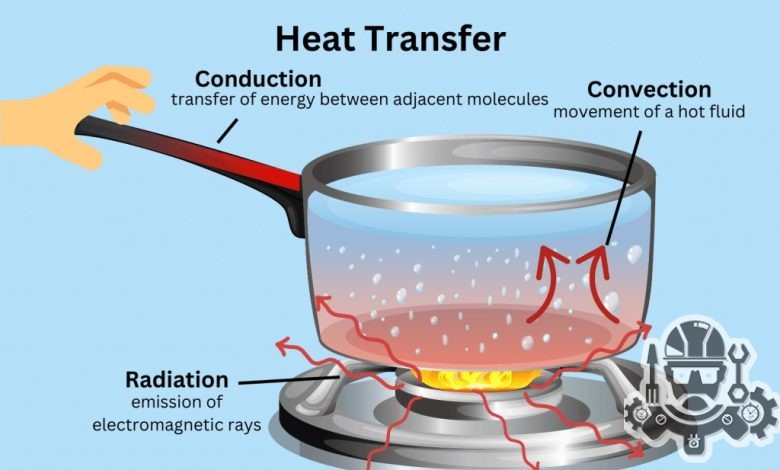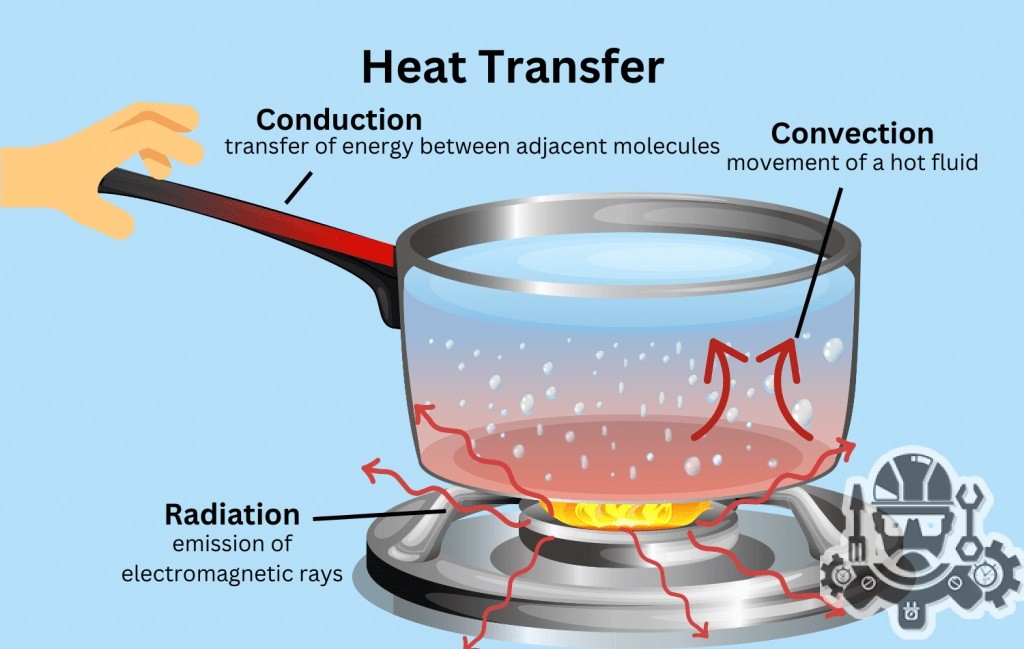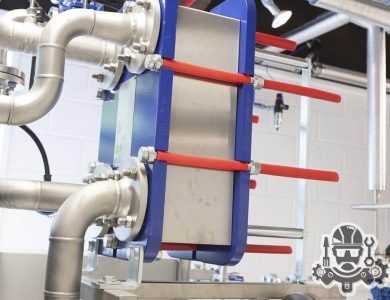Conduction, Convection, and Radiation Heat Transfer

Contents
What Is Heat Transfer?
Heat transfer is the process of transferring thermal energy from one object or substance to another. It occurs through three main modes: conduction, convection, and radiation. Conduction is the transfer of heat through direct contact between particles in a solid material. Convection is the transfer of heat through the movement of fluids, either liquids or gases. Radiation is the transfer of heat through electromagnetic waves, such as from the sun or a fire.
Understanding heat transfer is essential in various fields, including engineering, physics, and environmental science. It plays a crucial role in designing efficient systems and structures, as well as in predicting and controlling temperature distribution.
When studying heat transfer, calculations are often necessary to determine the amount of heat transferred and the resulting temperature changes. These calculations involve various factors, such as material properties, surface areas, and temperature gradients. By accurately calculating heat transfer, engineers can optimize designs, enhance energy efficiency, and ensure the safety and performance of systems.
Different Modes Of Heat Transfer
When it comes to understanding heat transfer, it is crucial to delve into the different modes of heat transfer. Heat transfer refers to the process by which thermal energy is transferred between two objects or systems that are at different temperatures. In simple terms, it is the movement of heat from a hotter object to a cooler object. This transfer can occur by three primary modes: conduction, convection, and radiation.

Conduction is the mode of heat transfer that occurs when energy is transferred through direct contact between two objects. This process relies on the direct collision of particles within the objects, causing energy to be transferred from the hotter object to the cooler one. The rate of conduction heat transfer depends on the thermal conductivity of the materials involved and the temperature difference between them.
Convection involves the transfer of heat through the movement of fluids or gases. This mode of heat transfer occurs when particles carry thermal energy as they move from one place to another. Convection can be further categorized into natural convection, which is the result of density differences caused by temperature variations, and forced convection, which occurs when an external force, such as a fan or pump, assists in the movement of fluids.
Radiation is a unique mode of heat transfer that does not require the presence of a medium. Instead, it relies on electromagnetic waves, mainly infrared radiation, to transfer heat from one object to another. Unlike conduction and convection, radiation can occur even in a vacuum. Objects with higher temperatures emit more radiation, and the transfer of heat occurs when the emitted radiation is absorbed by another object.
Understanding the different modes of heat transfer is essential in various fields, including engineering, physics, and thermodynamics. By comprehending how heat is transferred, scientists and engineers can design heat exchangers, insulation systems, and other devices that optimize heat transfer for specific applications. Whether in industrial processes, building design, or even cooking, a clear understanding of heat transfer modes allows for efficient use of energy and resources.
Importance Of Heat Transfer Calculation
Heat transfer calculation is an essential aspect in various industries, including engineering, physics, and even everyday life. It plays a crucial role in designing efficient systems, predicting thermal behavior, and ensuring safety measures. The **importance of heat transfer calculation** cannot be stressed enough, as it allows engineers and scientists to optimize processes, evaluate performance, and make informed decisions.
One of the primary reasons for conducting heat transfer calculations is to determine the transfer of thermal energy between objects or systems. This information is crucial for understanding how heat is generated, distributed, and dissipated in various applications. Whether it’s designing heat exchangers, evaluating thermal insulation materials, or analyzing the cooling requirements of electronic devices, accurate heat transfer calculations provide the foundation for efficient and effective solutions.
- Moreover, heat transfer calculations enable engineers to identify and manage potential risks. By understanding how heat flows through different materials and systems, it becomes possible to identify areas where heat concentrations may cause problems or lead to failure. This is particularly important in industries such as aerospace, where excessive heat can compromise the integrity of structural components. By calculating heat transfer rates, engineers can implement appropriate cooling strategies and ensure the safe operation of critical equipment.
| Table: Common Tools for Heat Transfer Calculation |
|---|
| 1. Heat transfer coefficient calculators |
| 2. Finite element analysis software |
| 3. Thermal imaging cameras |
| 4. Computational Fluid Dynamics (CFD) simulations |
| 5. Electrical circuit network analysis tools |
In addition to design and risk management, heat transfer calculations also play a crucial role in energy efficiency. By accurately calculating heat transfer rates, engineers can identify areas where heat loss is high and energy consumption is inefficient. This information can then be used to optimize systems, improve insulation, or develop more efficient heat exchange processes. Whether it’s designing HVAC systems for buildings or optimizing power generation plants, heat transfer calculations contribute significantly to reducing energy waste and promoting sustainability.
In conclusion, the **importance of heat transfer calculation** cannot be overlooked in various industries. It serves as the foundation for designing efficient systems, ensuring safety, managing risks, and promoting energy efficiency. By accurately calculating heat transfer rates and understanding thermal behavior, engineers and scientists can make informed decisions, optimize processes, and develop innovative solutions. As technology continues to advance, the significance of heat transfer calculations will only increase, enabling us to design a more sustainable and interconnected world.
Conduction Heat Transfer Calculation
Conduction heat transfer calculation plays a vital role in various industries and applications. It is the process by which heat is transferred through direct contact between two objects that are at different temperatures. Understanding and accurately calculating conduction heat transfer is crucial for designing efficient heat exchangers, insulation materials, and other thermal systems. In this blog post, we will explore the fundamentals of conduction heat transfer calculation and the methods used to determine the rate of heat transfer in different scenarios.
One of the essential parameters in conduction heat transfer calculation is the thermal conductivity of the material. The thermal conductivity represents the ability of a substance to conduct heat. It is denoted by the symbol “λ” and is measured in units of Watts per meter Kelvin (W/mK). Materials with higher thermal conductivity values transfer heat more effectively than those with lower values. Metals, such as copper and aluminum, are excellent conductors of heat, while insulating materials like rubber or wood have lower thermal conductivity.
To calculate the rate of heat transfer through conduction, the Fourier’s law of heat conduction is widely used. According to this law, the heat transfer rate (\(Q\)) is directly proportional to the temperature difference between the two objects (\(ΔT\)) and the cross-sectional area of contact (\(A\)), and inversely proportional to the thickness (\(L\)) of the material through which heat is being conducted. This can be mathematically expressed as:
| Q = (λ * A * ΔT) / L |
In this equation, the heat transfer rate (\(Q\)) is measured in Watts (W), the temperature difference (\(ΔT\)) is in Kelvin (K), the area (\(A\)) is in square meters (m²), and the thickness (\(L\)) is in meters (m). It is important to note that the equation assumes the material through which heat is being conducted has a constant thermal conductivity value.
When applying the conduction heat transfer calculation, it is necessary to consider different scenarios. For example, in the case of heat transfer through a flat wall with a constant cross-sectional area, the equation simplifies to:
- Q = (λ * A * ΔT) / L
This scenario assumes that heat flow occurs perpendicular to the surface and there are no other sources or sinks of heat within the wall. However, if the surface area changes or there are additional heat sources or sinks present, the calculation becomes more complex and requires incorporating suitable modifications into the equation.
In summary, conduction heat transfer calculation involves determining the rate of heat transfer between two objects through direct contact. It relies on the thermal conductivity of the material, temperature difference, cross-sectional area, and thickness. By applying Fourier’s law of heat conduction, engineers and designers can accurately analyze and optimize heat transfer processes. Whether it is designing efficient insulation systems or improving the performance of heat exchangers, understanding conduction heat transfer calculation is essential for various technological advancements and innovations.
Convection Heat Transfer Calculation
Convection heat transfer is the process of heat transfer that occurs when there is a flow of fluid, such as air or water, over a surface. It is an important phenomenon to understand in various fields, including engineering, meteorology, and environmental science. Convection occurs due to the movement of molecules, which carry kinetic energy and transfer it to other molecules. This transfer of energy can be quantified using various calculations and equations.
One of the key calculations in convection heat transfer is determining the convective heat transfer coefficient, denoted as “h.” This coefficient represents the ability of the fluid to transfer heat and is influenced by factors such as fluid properties, flow velocity, and surface characteristics. The convective heat transfer coefficient can be estimated using empirical correlations based on experimental data or calculated using analytical equations.
In order to calculate the convective heat transfer coefficient, several tools and techniques can be used. One commonly employed method is the use of Nusselt number correlations, which relate the convective heat transfer coefficient to dimensionless parameters such as Reynolds number, Prandtl number, and Grashof number. These correlations are derived from experimental data and provide a quick and efficient way to estimate the convective heat transfer coefficient for different flow conditions.
- Another tool that is often used in convection heat transfer calculations is the use of heat transfer coefficients for specific geometries or applications. These coefficients can be obtained from literature or empirical data and provide a more accurate estimation of the convective heat transfer coefficient for specific cases. For example, in heat exchangers, specific correlations are developed to calculate the convective heat transfer coefficient based on the geometry and fluid properties of the system.
| Advantages of Convection Heat Transfer Calculation: |
|---|
| 1. Accurate estimation of convective heat transfer coefficient |
| 2. Ability to optimize heat transfer systems |
| 3. Efficient design of heat exchangers and cooling systems |
| 4. Prediction of temperature distribution in fluids and solids |
In conclusion, convection heat transfer calculation plays a crucial role in understanding and analyzing the transfer of heat through fluids. It allows for the estimation of convective heat transfer coefficients, which are essential in designing and optimizing heat transfer systems. By using various tools and correlations, engineers and scientists can accurately predict the behavior and effects of convection heat transfer in different applications. Overall, convection heat transfer calculation is an important tool in the field of heat transfer and contributes to advancements in various industries.
Radiation Heat Transfer Calculation
Radiation heat transfer is one of the three modes of heat transfer, along with conduction and convection. Unlike conduction and convection, radiation heat transfer does not require a medium to transfer heat. It can occur through empty space, making it an important factor in various industrial applications and everyday life.
Radiation heat transfer occurs through electromagnetic waves, specifically through infrared radiation. These waves travel at the speed of light and can transfer heat from a hot object to a cooler one by emitting and absorbing radiation. The amount of heat transferred through radiation depends on several factors, such as the temperature difference between the objects, the surface area, and the emissivity of the materials involved.
Tools For Heat Transfer Calculation
In order to accurately calculate heat transfer in various systems, engineers and researchers rely on a variety of tools and software. These tools play a crucial role in determining heat transfer rates, optimizing thermal designs, and ensuring the efficiency of different devices. In this article, we will discuss some of the most commonly used tools for heat transfer calculation.
1. Heat Transfer Coefficient Estimation Tools:
One of the most important parameters in heat transfer calculations is the heat transfer coefficient, which represents the rate of heat transfer between a surface and a fluid. There are several tools available that help engineers estimate the heat transfer coefficient for different situations. These tools take into account factors such as fluid properties, flow rate, surface roughness, and geometry to provide accurate estimations.
2. Computational Fluid Dynamics (CFD) Software:
CFD software is widely used in heat transfer calculations, especially for complex geometries and boundary conditions. This software uses numerical methods to solve the governing equations of fluid flow and heat transfer. CFD software allows engineers to simulate and analyze the behavior of fluids and heat transfer within various systems. It provides detailed insights into flow patterns, temperature distributions, and heat transfer rates, aiding in the optimization of thermal designs.
3. Thermal Analysis Software:
Thermal analysis software is specifically designed to analyze heat transfer in different materials and structures. This software combines the principles of heat transfer with material properties and geometry to predict temperature distributions, heat fluxes, and thermal stresses. Engineers can use this software to simulate how heat is conducted within solid objects, enabling them to optimize designs, detect potential hotspots, and prevent thermal failures in various applications.
4. Thermal Imaging Cameras:
Thermal imaging cameras allow engineers to visually inspect heat transfer patterns and identify temperature variations on the surface of objects. These cameras detect infrared radiation emitted by objects and represent the temperature distribution using a color scale. By using thermal imaging cameras, engineers can quickly identify areas with excessive heating or cooling, diagnose heat transfer issues, and improve the overall thermal performance of systems.
5. Heat Transfer Enhancement Tools:
When designing heat exchangers or cooling systems, engineers often need to enhance heat transfer rates to improve overall efficiency. There are various tools available that assist in heat transfer enhancement, such as fins, turbulators, and heat transfer augmentation devices. These tools increase the effective heat transfer surface area or disrupt fluid flow, thereby enhancing convective heat transfer and improving thermal performance.
In conclusion, tools for heat transfer calculation play a vital role in accurately predicting heat transfer rates, optimizing thermal designs, and ensuring the efficiency of different systems. From estimating heat transfer coefficients to using advanced software and thermal imaging cameras, these tools enable engineers to make informed decisions and improve the overall heat transfer performance of various applications.
Heat transfer is the process of exchanging thermal energy between two or more objects or systems. It occurs through three different modes: conduction, convection, and radiation.
The different modes of heat transfer are:
Conduction: Heat transfer occurs through direct contact between objects or particles that are in physical contact with each other.
Convection: Heat transfer occurs through the movement of fluids (liquids or gases), which carry heat energy from one place to another.
Radiation: Heat transfer occurs through electromagnetic waves, which can travel through vacuum or transparent mediums.
Heat transfer calculation is important because it allows engineers and designers to determine the amount of heat transferred in a system or process. This information is crucial for designing efficient heating or cooling systems, optimizing energy consumption, and ensuring the safety and comfort of individuals.
Conduction heat transfer can be calculated using Fourier's law of heat conduction, which states that the heat transfer rate is proportional to the temperature gradient and the surface area, and inversely proportional to the thickness of the material.
Convection heat transfer can be calculated using empirical correlations or equations, which take into account parameters such as fluid velocity, temperature difference, surface area, and fluid properties (density, viscosity, etc.). These correlations vary depending on the type of flow (forced or natural convection) and the geometry of the system.
Radiation heat transfer can be calculated using Stefan-Boltzmann's law, which states that the heat transfer rate is proportional to the emissivity of the radiating surface, the temperature difference between the radiating surface and the surroundings, and the surface area.
Several tools and software programs are available for heat transfer calculation, including:
Finite Element Analysis (FEA) software
Computational Fluid Dynamics (CFD) software
Thermal analysis software
Heat transfer calculators and spreadsheets



